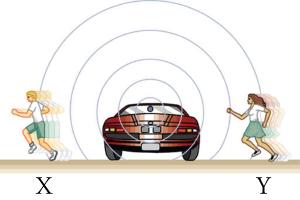The Doppler Effect of Sound Waves
The Doppler effect is a change in the observed pitch of a sound, due to relative motion between the source and the observer. An example of the Doppler effect due to the motion of a source occurs when you are standing still, and the sound of a siren coming from an ambulance shifts from high-pitch to low-pitch as it passes by. The closer the ambulance is to you, the more sudden the shift. The faster the ambulance moves, the greater the shift. We also hear this shift in frequency for passing race cars, airplanes, and trains. An example of the Doppler effect with a stationary source and moving observer is if you ride a train past a stationary warning bell, you will hear the bell’s frequency shift from high to low as you pass by.
What causes the Doppler effect? Let’s compare three different scenarios: Sound waves emitted by a stationary source (Figure 14.15), sound waves emitted by a moving source (Figure 14.16), and sound waves emitted by a stationary source but heard by moving observers (Figure 14.17). In each case, the sound spreads out from the point where it was emitted.
If the source and observers are stationary, then observers on either side see the same wavelength and frequency as emitted by the source. But if the source is moving and continues to emit sound as it travels, then the air compressions (crests) become closer together in the direction in which it’s traveling and farther apart in the direction it’s traveling away from. Therefore, the wavelength is shorter in the direction the source is moving (on the right in Figure 14.16), and longer in the opposite direction (on the left in Figure 14.16).
Finally, if the observers move, as in Figure 14.17, the frequency at which they receive the compressions changes. The observer moving toward the source receives them at a higher frequency (and therefore shorter wavelength), and the person moving away from the source receives them at a lower frequency (and therefore longer wavelength).
We know that wavelength and frequency are related by where v is the fixed speed of sound. The sound moves in a medium and has the same speed v in that medium whether the source is moving or not. Therefore, f multiplied by is a constant. Because the observer on the right in Figure 14.16 receives a shorter wavelength, the frequency she perceives must be higher. Similarly, the observer on the left receives a longer wavelength and therefore perceives a lower frequency.
The same thing happens in Figure 14.17. A higher frequency is perceived by the observer moving toward the source, and a lower frequency is perceived by an observer moving away from the source. In general, then, relative motion of source and observer toward one another increases the perceived frequency. Relative motion apart decreases the perceived frequency. The greater the relative speed is, the greater the effect.
Watch Physics
Introduction to the Doppler Effect
This video explains the Doppler effect visually.
Grasp Check
If you are standing on the sidewalk facing the street and an ambulance drives by with its siren blaring, at what point will the frequency that you observe most closely match the actual frequency of the siren?
- when it is coming toward you
- when it is going away from you
- when it is in front of you
For a stationary observer and a moving source of sound, the frequency (fobs) of sound perceived by the observer is
14.11
where fs is the frequency of sound from a source, vs is the speed of the source along a line joining the source and observer, and vw is the speed of sound. The minus sign is used for motion toward the observer and the plus sign for motion away from the observer.
Tips For Success
Rather than just memorizing rules, which are easy to forget, it is better to think about the rules of an equation intuitively. Using a minus sign in will decrease the denominator and increase the observed frequency, which is consistent with the expected outcome of the Doppler effect when the source is moving toward the observer. Using a plus sign will increase the denominator and decrease the observed frequency, consistent with what you would expect for the source moving away from the observer. This may be more helpful to keep in mind rather than memorizing the fact that “the minus sign is used for motion toward the observer and the plus sign for motion away from the observer.”
Note that the greater the speed of the source, the greater the Doppler effect. Similarly, for a stationary source and moving observer, the frequency perceived by the observer fobs is given by
14.12
where vobs is the speed of the observer along a line joining the source and observer. Here the plus sign is for motion toward the source, and the minus sign is for motion away from the source.




